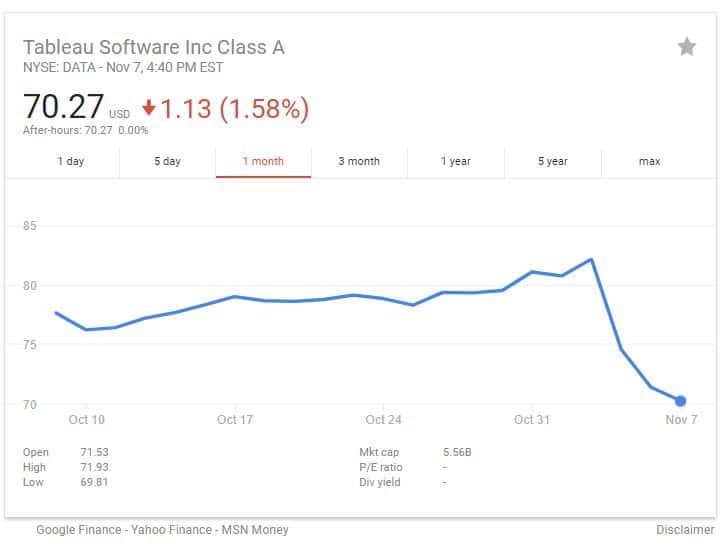Source: Tableau

Last week Seattle-based Tableau Software (NYSE: DATA) reported its third quarter financials for the period ended September 30, 2017. While the company cited strong subscription demand and annual recurring revenue growth for the quarter, it missed analyst expectations for revenue and profit, due to the shift from a licensing model to a subscription model, according to Barron’s. The Q3 results caused Tableau stock to drop from $82.17 per share last Thursday to $70.27, as of 4:40 p.m. Eastern on Tuesday.
Source: Google Finance

Financial highlights for the quarter include:
- Total revenue was $214.9 million, a 4 percent year-over-year increase, but less than the projected $219 million.
- Total annual recurring revenue was $526.2 million, a 46 percent increase year-over-year.
- Subscription annual recurring revenue was $139.2 million, a 204 percent increase year-over-year, up from $45.7 million.
- Ratable license bookings were 45 percent of total license bookings, compared to 16 percent for the same period last year.
- GAAP net loss was $46.6 million, or $0.59 per diluted common share, compared to $30.3 million, or $0.40 per diluted common share, for the third quarter of 2016.
- The company reported total assets of $1.319 billion, compared to $1.287 billion for the same period last year.
‘Customers are embracing our subscription offerings even faster than expected,’ said Adam Selipsky, President and Chief Executive Officer of Tableau. ‘Forty-five percent of our license bookings were sold on a subscription basis this quarter, nearly triple the percentage a year ago, as more and more customers turn to subscription to better address their analytics needs with lower upfront cost and reduced risk.’
In terms of revenue, license revenue of $99.4 million made up 46.3 percent of total revenue. Maintenance and services revenue of $115.5 million made up 53.7 percent of total revenue. For the same period last year, the split was 56.6 percent and 43.4 percent, respectively.
Operational highlights for the quarter include:
- The launch of Tableau 10.4 with data source certification, functionality for smarter team discussions and viz snapshots, and new geospatial capabilities.
- Tableau acquired ClearGraph, a startup that enables smart data discovery and data analysis through natural language query technology.
- The company hosted its tenth annual customer conference in Las Vegas with 14,000 registered customers and partners in attendance.
- At the end of Q3, the company had more than 65,000 customers, compared to more than 61,000 at the end of Q2, and compared to more than 50,000 at the end of Q3 2016.
- During the quarter, Tableau had 337 deals greater than $100,000, and 13 greater than $1 million.
Chief Financial Officer Thomas Walker commented on the financial results for the quarter during the earnings call.
‘The faster-than-expected pace of subscription results in lower near-term revenue and profitability, as we build a recurring revenue base,’ Walker said.
Regarding the accelerated adoption of the subscription model, Walker added, ‘We are pleased with this progress so far, and continue to believe that making faster progress is better, even if it results in lower near-term revenue and profitability. As you know, we believe the shift to subscription is good for our customers and our shareholders over the long-term as it creates recurring revenue streams, generates more predictable results, and expands our overall market opportunity.’
The outlook for the fourth quarter is as follows:
- Tableau estimates a non-GAAP operating loss/income to range between a $4 million loss to a gain of $3 million.
- They expect the non-GAAP earnings per share between a $0.01 per share loss to a $0.05 per share gain.
Insider Take:
Investors may not have been impressed with Tableau’s Q3 results, but the company is in it for the long play. They are transitioning to a subscription model from a perpetual licensing model, which changes how and when revenue is recognized. While the revenue recognition changes, expenses do not. As Walker explains in the earnings call, commissions are still earned and paid, no matter whether the salesperson sells a subscription or a license.
This skews the numbers, but this doesn’t mean that Tableau is failing. In fact, it shows that they are succeeding and adoption of the subscription model by their customers is moving faster than expected. Customers now have a lower barrier to entry so Tableau’s product is more attractive. It may hurt the company’s bottom line in the short term, but moving to a subscription model will ultimately benefit Tableau, its customers and its investors.








